
Citadel Hill is a hill that is a National Historic Site in Halifax, Nova Scotia, Canada. Four fortifications have been constructed on Citadel Hill since the city was founded by the English in 1749, and were referred to as Fort George—but only the third fort was officially named Fort George. According to General Orders of October 20, 1798, it was named after King George III. The first two and the fourth and current fort, were officially called the Halifax Citadel. The last is a concrete star fort.

Halifax Stanfield International Airport is a Canadian airport in Goffs, Nova Scotia, a rural community of the Halifax Regional Municipality. It serves the Halifax region, mainland Nova Scotia, and adjacent areas in the neighbouring Maritime provinces. The airport is named in honour of Robert Stanfield, the 17th Premier of Nova Scotia and former leader of the federal Progressive Conservative Party of Canada.

Halifax is the capital and largest municipality of the Canadian province of Nova Scotia, and the largest municipality in Atlantic Canada. As of 2022, it is estimated that the population of the Halifax CMA was 480,582, with 348,634 people in its urban area. The regional municipality consists of four former municipalities that were amalgamated in 1996: Halifax, Dartmouth, Bedford, and Halifax County.

A multistorey car park or parking garage, also called a multistorey, parking building, parking structure, parkade, parking ramp, parking deck, or indoor parking, is a building designed for car, motorcycle, and bicycle parking in which parking takes place on more than one floor or level. The first known multistorey facility was built in London in 1901, and the first underground parking was built in Barcelona in 1904. The term multistorey is almost never used in the US, because almost all parking structures have multiple parking levels. Parking structures may be heated if they are enclosed.
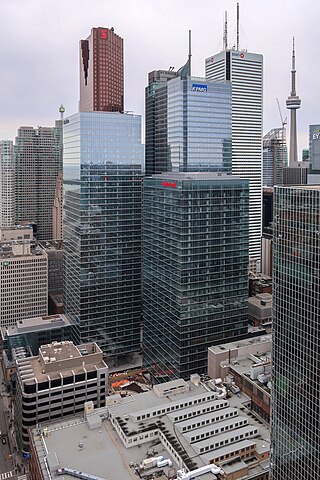
The Bay Adelaide Centre is an office complex in the Financial District of Toronto, Ontario, Canada. The first phase, a 51-storey skyscraper known as Bay Adelaide West, was completed in July 2009. The second phase, the 44-storey Bay Adelaide East, was completed in October 2016. A third tower, Scotiabank North Tower, opened in 2022 and serves the new global head office of Canadian bank Scotiabank.

Purdy's Wharf is an office complex in Halifax, Nova Scotia, Canada. Built over the water at the edge of Halifax Harbour and resting on pilings, it consists of two office towers, and a smaller office structure called Purdy's Landing. The complex is located along the Halifax Waterfront Boardwalk.

Scotia Square is a commercial development in downtown Halifax, Nova Scotia, Canada. It was built from the late 1960s to late 1970s and is managed by Crombie REIT.

1801 Hollis Street is an office building in downtown Halifax, Nova Scotia, Canada. Completed in 1985, it is one of the tallest buildings in Halifax, at 87 metres, with 22 floors. It was built as the corporate headquarters of Central Trust, one of the largest trust companies in Canada in the 1980s, and was originally known as Central Trust Tower.
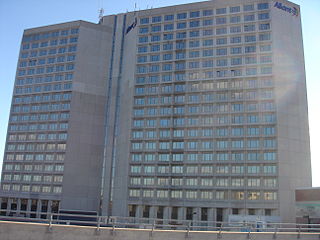
The Maritime Centre, in Downtown Halifax, Nova Scotia, Canada, is an office building, home to the regional telecommunications company Bell Aliant. The main entrance to the building sits on the prominent corner of Barrington Street and Spring Garden Road.

Barrington Street is a major street in Halifax, Nova Scotia, Canada, running from the MacKay Bridge in the North End approximately 7 km south, through Downtown Halifax to Inglis Street in the South End. Its civic numbers range from 950 to 4756 on the Halifax Peninsula street grid numbering system.
The Lexington Transit Center is a two-story public transportation facility utilized by Lextran and other regional transit services with a five-story underground parking garage along East Vine Street and East High Street east of South Limestone in Lexington, Kentucky. It features twelve bus stalls on E. Vine Street, four bus capacity on E. High Street, two indoor waiting rooms with restrooms and vending, and three clerk booths for ticket sales and customer service, with buses running every 35 minutes for much of the day. Completion of the transit center occurred in 1990 and was completed in conjunction with the Harrison Avenue viaduct reconstruction.
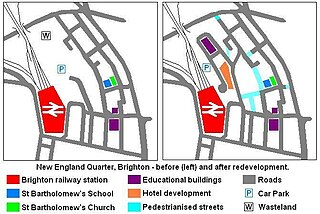
The New England Quarter is a mixed-use development in the city of Brighton and Hove, England. It was built between 2004 and 2008 on the largest brownfield site in the city, adjacent to Brighton railway station. Most parts of the scheme have been finished, but other sections are still being built and one major aspect of the original plan was refused planning permission.

Seattle Municipal Tower is a skyscraper in downtown Seattle, Washington. At 220.07 m (722.0 ft), it is the fifth-tallest building in the city. Completed in 1990, it was initially named AT&T Gateway Tower and subsequently KeyBank Tower after its anchor tenants AT&T and KeyBank. It was given its current name on May 17, 2004.

Park Lane is a three-storey shopping mall with 40+ shops in Halifax, Nova Scotia, Canada. It is located on Spring Garden Road and is owned by Universal Properties.

Kent station is a train station in the city of Kent, Washington, United States, served by the S Line of the Sounder commuter rail network. It is located in downtown Kent and consists of two train platforms connected via a pedestrian overpass, a parking garage, and several bus bays. The station also has 996 parking stalls and is served by King County Metro and Sound Transit Express buses. Train service to Kent began in 2001 and the station's garage opened the following year. King County Metro began service from the bus bays in 2005, after a third phase of construction. Sound Transit plans to build a second parking garage in 2027 to accommodate additional demand at the station.
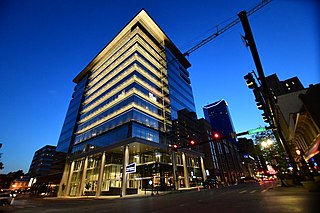
City Center, formerly known as CentrePointe, is a residential, commercial, and retail building in downtown Lexington, Kentucky that opened in 2020. The plan consists of a 12-story office tower incorporating premium luxury condominiums in its top three floors, two hotels, retail spaces and an underground parking garage. The parking garage was completed in 2017.

The Grand Parade is an historic military parade square dating from the founding of Halifax in 1749. At the north end of the Grand Parade is the Halifax City Hall, the seat of municipal government in Nova Scotia's Halifax Regional Municipality. At the south end is St. Paul's Church. In the middle of Grand Parade is the cenotaph built originally to commemorate the soldiers who served in World War I.
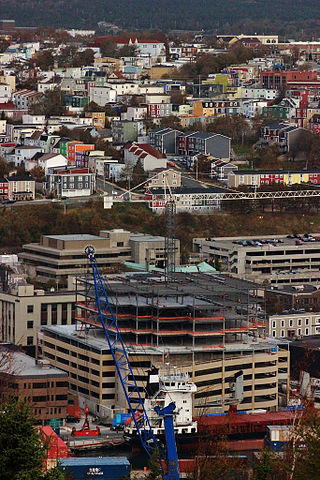
351 is a 165,000-square-foot office building. The high-rise is in downtown St. John's, Newfoundland and Labrador, at 351 Water Street. The office building is the first to be constructed downtown in 25 years and was completed in 2013 by East Port Properties.

The Halifax Convention Centre is the main conference centre in Halifax, Nova Scotia, Canada. It opened on December 15, 2017 in Downtown Halifax, replacing the older World Trade and Convention Centre.

The Cogswell Interchange is a multi-level highway interchange in downtown Halifax, Nova Scotia, Canada. It was built as the first stage of a greater scheme for an elevated freeway, called Harbour Drive, which would have run south through downtown and necessitated demolition of much of the downtown building stock. The plan was halted in the face of significant public opposition, but the Cogswell Interchange remains a visible reminder, occupying a large amount of prime land and posing a barrier to pedestrian movement.





















